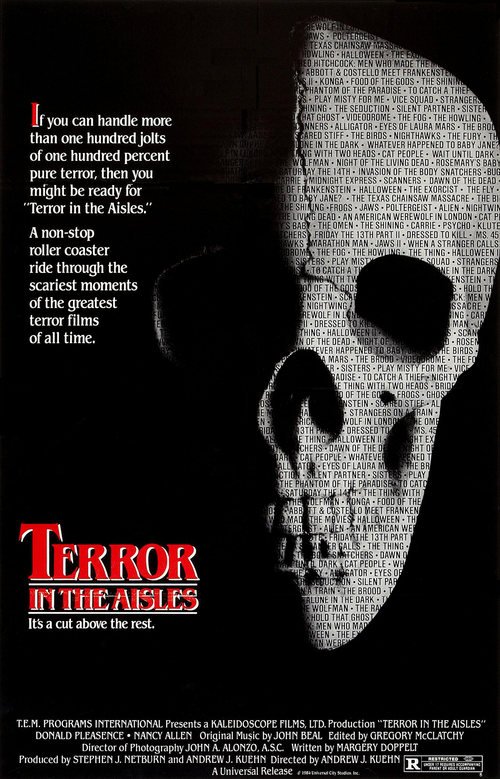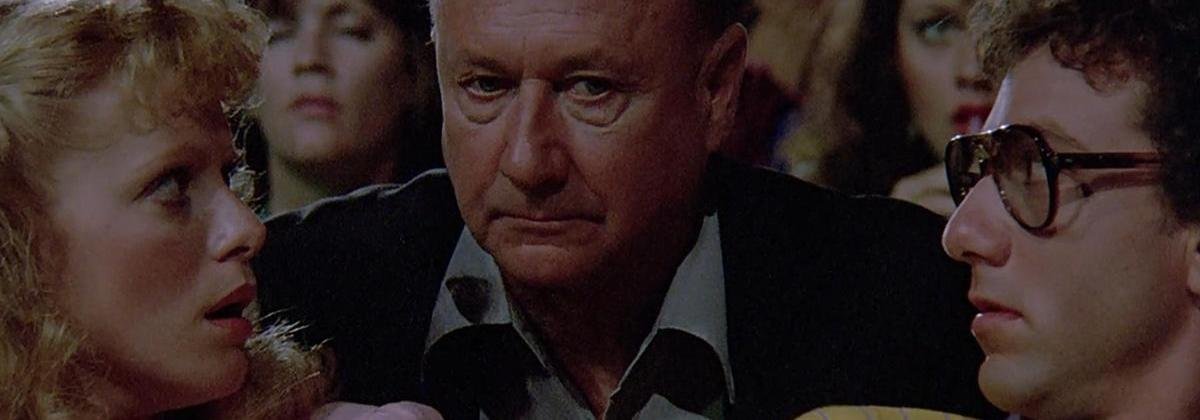TERROR IN THE AISLES: The Malevolent Magic Of Editing
Terror In The Aisles is a miracle if you think about it. This horror film compilation, a staple of video rental shops during the '80s and '90s, is the kind of film that would be virtually impossible to make today. To begin with, it relies on lengthy clips from properties belonging to a variety of studios and re-edits them into new montages that would probably require dozens of people to sign off on today. The wildest thing about this compilation is that it actually made it into theaters and enjoyed a bit of box office success.Sadly, Terror In The Aisles isn't that admired despite these unique achievements. It slipped into obscurity after the VHS era, not resurfacing until it was added as a surprise extra to a blu-ray release of Halloween II in 2011. Some horror fans were happy at this reappearance but others have dismissed it as dated or misguided. Certain detractors dismiss it as the glorified version of a basic cable film-clip t.v. special. Another common criticism is that it doesn't stick exclusively to horror films, weaving in extensive footage from tense but non-horrific films like Nighthawks, Marathon Man and Midnight Express.That said, such criticisms miss a lot of the appeal that makes Terror In The Aisles an evergreen with its fanbase. It's not a clip show so much as it is a cinematic mixtape, one assembled in an audience-friendly manner that displays an impressive level of editing skill. The setup for Terror In The Aisles offers a kind of bubblegum post-modernism in its approach to discussing "terror films." We watch a fictional audience, including onscreen narrators Donald Pleasance and Nancy Allen, as clips from about eighty horror and thriller films unfurl before them. Pleasance And Allen muse about the appeal of horror films and the motivations of the audience watching them, with the filmmakers using scenes from the films to show a practical application of their theories.In fairness to the film's critics, this is a setup that anyone who's ever watched a "best horror films" t.v. special is familiar with. All its theories about the whys of the horror genre and the psychology of the genre's fans are all pretty familiar, entry-level stuff.However, it's the editing that makes Terror In The Aisles special. Director Andrew J. Kuehn was the head of Kaleidoscope Pictures, which played a big role in creating the modern movie trailer (sample credits: The French Connection, Jaws, Back To The Future) and he and his team bring that kind of slick yet punchy editorial acumen to the fore here.A savvy approach to building visual associations is what brings Terror In The Aisles into "cinematic mixtape" territory. With editors Bill Flicker and Gregory McClatchy, Kuehn often crosscuts between multiple films to create a composite sequence that builds to its own unique crescendo. For example, there's a great moment where scenes from Ms. 45 and Klute are intercut, with the killer from Klute's climactic monologue playing out over the montage until the magic of crosscutting makes it appear that the gun-toting heroine of Ms. 45 "silences" him.
The setup for Terror In The Aisles offers a kind of bubblegum post-modernism in its approach to discussing "terror films." We watch a fictional audience, including onscreen narrators Donald Pleasance and Nancy Allen, as clips from about eighty horror and thriller films unfurl before them. Pleasance And Allen muse about the appeal of horror films and the motivations of the audience watching them, with the filmmakers using scenes from the films to show a practical application of their theories.In fairness to the film's critics, this is a setup that anyone who's ever watched a "best horror films" t.v. special is familiar with. All its theories about the whys of the horror genre and the psychology of the genre's fans are all pretty familiar, entry-level stuff.However, it's the editing that makes Terror In The Aisles special. Director Andrew J. Kuehn was the head of Kaleidoscope Pictures, which played a big role in creating the modern movie trailer (sample credits: The French Connection, Jaws, Back To The Future) and he and his team bring that kind of slick yet punchy editorial acumen to the fore here.A savvy approach to building visual associations is what brings Terror In The Aisles into "cinematic mixtape" territory. With editors Bill Flicker and Gregory McClatchy, Kuehn often crosscuts between multiple films to create a composite sequence that builds to its own unique crescendo. For example, there's a great moment where scenes from Ms. 45 and Klute are intercut, with the killer from Klute's climactic monologue playing out over the montage until the magic of crosscutting makes it appear that the gun-toting heroine of Ms. 45 "silences" him. Other highlights: a tense "heroines under attack" section that connects scenes from When A Stranger Calls, Halloween II and The Shining, the finales of Vice Squad and Nighthawks intercut in a rousing way and a killer opening titles scene that draws from countless films to create a mastercut of multiple protagonists barricading themselves in houses from several killers.Not only are these montages deftly edited, they also frequently include a strong new soundtrack by John Beal, a trailer scoring specialist who also wrote the fantastic score for The Funhouse. He effectively emulates the styles of multiple composers to create excellent soundalike cues that unify the sequences.It's also worth noting that the new "in the theater" sections are deftly shot by veteran cinematographer John Alonzo: they're light in comparison to the montages but include fun bits like Pleasance cheering on a clip from Halloween and Allen watching her famous monologue during the finale of Dressed To Kill.
Other highlights: a tense "heroines under attack" section that connects scenes from When A Stranger Calls, Halloween II and The Shining, the finales of Vice Squad and Nighthawks intercut in a rousing way and a killer opening titles scene that draws from countless films to create a mastercut of multiple protagonists barricading themselves in houses from several killers.Not only are these montages deftly edited, they also frequently include a strong new soundtrack by John Beal, a trailer scoring specialist who also wrote the fantastic score for The Funhouse. He effectively emulates the styles of multiple composers to create excellent soundalike cues that unify the sequences.It's also worth noting that the new "in the theater" sections are deftly shot by veteran cinematographer John Alonzo: they're light in comparison to the montages but include fun bits like Pleasance cheering on a clip from Halloween and Allen watching her famous monologue during the finale of Dressed To Kill. In short, horror fans need to stop getting hung up on whether or not this film picked the right clips or was specific enough in its definition of horror. Put all that purist nonsense aside and just groove on how it is put together. The intercutting brings a fresh context to familiar scenes and allows you to appreciate them all over again. The filmmakers in the audience can also learn a lot from the precision of this editing. All these qualities make Terror In The Aisles the kind of deftly-crafted cinematic mixtape you can enjoy again and again.
In short, horror fans need to stop getting hung up on whether or not this film picked the right clips or was specific enough in its definition of horror. Put all that purist nonsense aside and just groove on how it is put together. The intercutting brings a fresh context to familiar scenes and allows you to appreciate them all over again. The filmmakers in the audience can also learn a lot from the precision of this editing. All these qualities make Terror In The Aisles the kind of deftly-crafted cinematic mixtape you can enjoy again and again.


